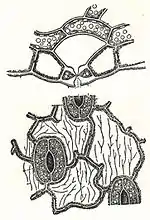Stomata (stŏm′ȧ-tȧ) (in plants). Narrow
openings are developed in the epidermis of
 STOMATA AND LEAF
all aërial parts
of plants which
require and
emit gases.
(See
Aëration.)
Gaseous exchanges
especially
abound in
green tissues;
hence stomata
are chiefly
displayed by the
foliage-leaves
of the higher
plants. Each
stoma consists
of two specially
organized
epidermal
cells, called
guard-cells,
which are
crescentic in surface-view and, being in
contact by their concave faces, leave a
lens-shaped opening between them. This
opening leads into the system of intercellular
passageways among the working-cells,
and thus provides for a free exchange of
gaseous substances between the working-cells
and the outside air. The guard-cells
change form with the varying amounts of
moisture in the air, and so regulate the size
of the opening between them. Stomata
have been called “automatic gateways” on
account of this peculiar power of the guard-cells.
See Leaf and Transpiration.
STOMATA AND LEAF
all aërial parts
of plants which
require and
emit gases.
(See
Aëration.)
Gaseous exchanges
especially
abound in
green tissues;
hence stomata
are chiefly
displayed by the
foliage-leaves
of the higher
plants. Each
stoma consists
of two specially
organized
epidermal
cells, called
guard-cells,
which are
crescentic in surface-view and, being in
contact by their concave faces, leave a
lens-shaped opening between them. This
opening leads into the system of intercellular
passageways among the working-cells,
and thus provides for a free exchange of
gaseous substances between the working-cells
and the outside air. The guard-cells
change form with the varying amounts of
moisture in the air, and so regulate the size
of the opening between them. Stomata
have been called “automatic gateways” on
account of this peculiar power of the guard-cells.
See Leaf and Transpiration.